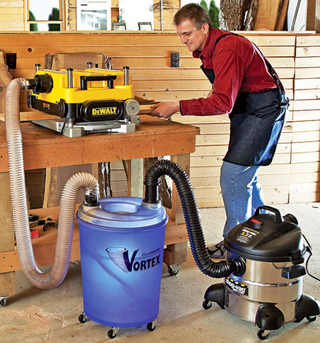
I have a 1-1/2 HP dust collector that has a 4-inch intake. I’d like to add a primary separator to it, but I don’t want to spend a lot of money on a 4-inch cyclone unit. Would it make sense to buy one of the 2-1/2 inch units and run a reducer and expander on the inlet and outlet, or would the increased velocity [about four times as much] not give me the separation I am hoping for? Do the garbage can units provide sufficient separation? I’d appreciate any guidance you can give me on this subject. — Don Dziubakowski
Tim Inman: You don’t say how big your shop is, whether you’re operating a commercial operation, or working in a “hobby shop” on Saturday mornings. The answers make a difference. For me, who makes a pretty good whack of my living working alone in a 4,000 square foot shop, I’d go with the “garbage can” preseparator approach. If you have a money tree in the back someplace, then go with a more elaborate system.
Chris Marshall: In his book Woodshop Dust Control (Taunton Press, 2002), Sandor Nagyszalanczy says that a “garbage can” preseparator not only turns a single-stage system like the one you have into a two-stage unit, but it also offers more chip-holding capability. The tradeoff is that the preseparator may limit your dust collector’s portability, and you should expect some loss of collection power due to the added energy it takes to draw air through the preseparator.
He doesn’t comment on connecting one of the smaller preseparators designed for shop vacuums to a full-size single-stage collector, but he does say that using one of these on a shop vacuum requires a powerful vacuum of at least 10 amps. You’ll get modest results when using one of these shop vacuum systems to collect debris from smaller power tools, and don’t expect thorough chip collection from larger machines like planers or table saws.





